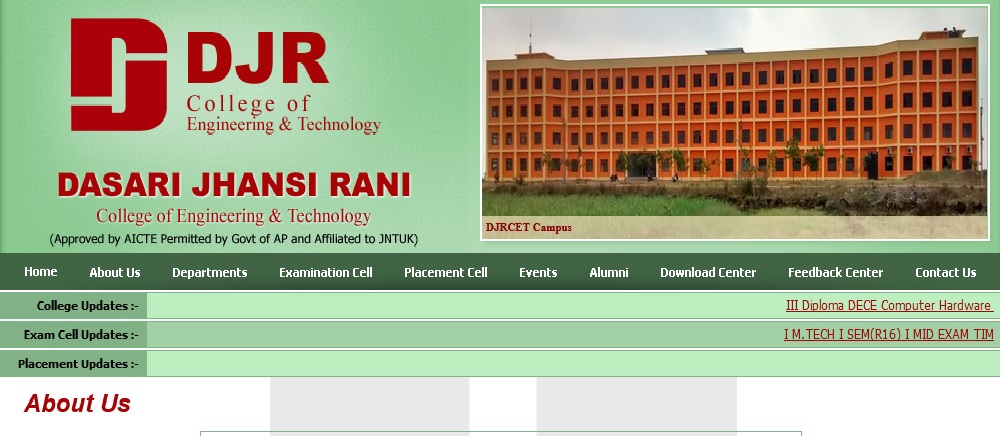R05320401 Telecommunication Switching Systems And Networks B.Tech Question Paper : djriet.edu.in
Name of the College : Dasari Jhansi Rani Institute Of Engineering And Technology
University : JNTUK
Department : Electronics & Communication Engineering
Subject Code/Name : R05320401 – Telecommunication Switching Systems And Networks
Year : 2008
Degree : B.Tech
Year/Sem : III/II
Website : djriet.edu.in
Document Type : Model Question Paper
Download Model Question Paper : https://www.pdfquestion.in/uploads/djriet.edu.in/3027-R05320401-TELECOMMUNICATION-SWITCHING-SYSTEMS-AND-NETWORKS.pdf
DJRIET Telecommunication Switching Systems Question Paper
III B.Tech II Semester Regular Examinations, Apr/May 2008 :
TELECOMMUNICATION SWITCHING SYSTEMS AND NETWORKS :
( Common to Electronics & Communication Engineering and Electronics & Telematics)
Time: 3 hours
Max Marks: 80
Answer any FIVE Questions :
Related : Noorul Islam College of Engineering R05310401 Linear Ic Applications B.Tech Question Paper : www.pdfquestion.in/3030.html
Set – I
All Questions carry equal marks :
1. (a) Why is it necessary to keep the magnetic diaphragm in an earphone displaced from its unstressed position? How is this achieved?
(b) What happens if the ratio f/f0 is not very small in case of an earphone?
(c) Estimate the bandwidth requirements of a single satellite that is to support 20 million telephone conversations simultaneously. [8+4+4]
2. (a) Explain the operation of input controlled and output controlled time division space switch with the help neat sketches?
(b) A PABX is designed using an output-controlled digital time division space switch for supporting 128 subscribers. The transmission between the subscribers and the exchange is analog. On an average, 25 % of the subscribers are active simultaneously, compare the cost of output- controlled and memory controlled configurations. [8+8]

3. (a) A subscriber loop of 18km is to be supported from an exchange that uses a 40 V battery with a 400 short-circuit protection resistance. Electronic telephones are used as the subscriber instruments. Determine the wire gauge that needs to be used.
(b) Explain in detail about telecommunication network topologies? [8+8]
4. (a) Define grade of service? Give expression for grade of service and explain why it is called as call congestion.
(b) The traffic statistics of a company using a PABX indicates that 180 out-going
calls are initiated every hour during working hours. Equal number of calls comes in. Each call lasts for 200 seconds on the average . If the GOS required is 0.05, determine the number of lines required between the PABX and the main exchange. [8+8]
5. (a) Describe data communication circuit configurations.
(b) What are the components of Data Communication network ? Explain. [8+8]
6. (a) Define open system interconnection. Name and explain functions of each of the Layers of the OSI model.
(b) Describe the operation of star, bus ring and hybrid Network topologies [8+8]
7. (a) What are the data link protocols used by ISDN ? Explain.
(b) Describe the four categories of messages in the ISDN network layer [8+8]
8. (a) Explain the format of STS 1 frame in details.
(b) What are the functions of STS- Multiplexes and add / drop multiplexers.
(c) Explain device layer relationship in SONET [6+6+4]
Set – II
1. (a) Compare the features of single stage and multistage switching network configurations?
(b) A fully connected network supports full duplex communication using unidirectional links. Show that the total number of links in such a network with n nodes, is given by 2× nC2. [8+8]
2. (a) Define each of the following terms: program, procedure, processor, process, user, task, job and subroutine.
(b) Find the blocking probability of a three stage network for M=N=2048,p=q=16 and a = 0.1 for S= 16, 24 and 32. [8+8]
3. (a) What are the major components of telecommunication network? Explain in detail about subscriber loop systems.
(b) An exchange uses a -40 V battery to derive subscriber lines. A resistance of 250 is placed in series with the battery to protect it from short circuits. The subscribers are required to use a standard telephone set which offers a d.c. resistance of 50 . The microphone requires 23mA for proper functioning. Determine the farthest distance from the exchange at which a subscriber can be located if 26 AWG conductor is used. [8+8]
4. (a) What are the different types of busy hours defined by CCITT? Explain.
(b) In a group of 10 servers, each is occupied for 30 minutes in an observation interval of two hours. Calculate the traffic carried by the group. [8+8]
5. (a) Explain the functions and features of data communication network components.
(b) Discuss peer to peer client / server networks. [8+8]
6. (a) Compare and contrast standard Ethernet, Fast Ethernet and Gigabit Ethernet.
(b) What is looping problem in transparent Bridges? How is it avoided using spanning tree algorithm [8+8]
7. (a) Compare HDLC and LAPD protocols.
(b) Describe ISDN, functional architecture and standards of ISDN Channels. [6+10]
8. (a) Explain the operation of cable modem
(b) Discuss features of HFC Networks. [8+8]